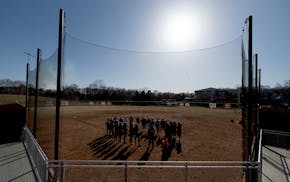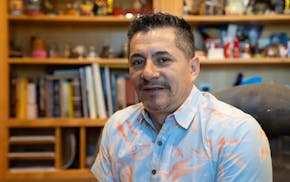Minnesota colleges and universities draw nearly 15,000 international students, who bring an estimated $488 million to the state — critical revenue schools could lose if fewer international students enroll next fall after major changes by the Trump administration.
That would also reshape the makeup of campuses. College officials say international students offer valuable culture and the perspective of other parts of the world that many American students wouldn't otherwise experience.
"International students make us smarter and safer," said Minnesota State Chancellor Scott Olson, who leads the state's system of 33 public institutions.
International students across the country have been under siege since President Donald Trump took office, with his administration announcing last week that it is pausing interviews for student visa applicants, reportedly to consider vetting students' social media accounts. Then, on Wednesday, Secretary of State Marco Rubio announced the administration would revoke the visas of some Chinese students.
At Harvard University, Trump recently tried to ban the enrollment of any international students but a judge ruled against it.
Those moves came after the administration revoked visas and immigration statuses for dozens of international students enrolled in Minnesota schools this year, part of a broader attack on higher education by the administration, pulling funding from colleges and universities across the country.
"We love having international students on our campuses, for one because it enriches the whole learning environment for everybody," Olson said. "And No. 2 is kind of a downstream effect — when they go back home, they'll go as ... ambassadors for Minnesota."
About one-fifth of international students enrolled in Minnesota colleges and universities last academic year were from India; another one-fifth were from China, according to the New York-based International Educational Exchange's 2023-2024 Open Doors report.
The biggest international student population is at the University of Minnesota, which drew 5,712 international students in fall 2024 from more than 140 countries, with 5,400 of them enrolled at the Twin Cities campus.
International students at that campus brought $229 million to the state in tuition, room and board and other daily expenditures in 2023-2024 while at Duluth's campus, they had a $6 million impact, according to data from NAFSA, the Association of International Educators.
At Bethany Lutheran College in Mankato, 134 international students made up about 20% of the undergraduate student body last year, holding festivals, contributing to sports and extracurriculars and volunteering in the community, spokesperson Lance Schwartz said.
Minnesota State enrolled 4,691 international students during the spring semester, with Normandale Community College and Minneapolis College having the highest totals among colleges, and Minnesota State, Mankato and St. Cloud State University with the most among universities.
Of the recent obstacles facing international students, Rachel Banks, the senior director for public policy at NAFSA, said the visa pause could affect the most people. But the Harvard ban is significant because it's clearly meant as a warning to other colleges and universities, she said.
"It's yet another misguided and troubling attack against international students that adds to a long list of already troubling actions," Banks said. "International students, they are the most tracked and vetted non-immigrant category, and they're the only ones that are tracked through ... a database."
NAFSA's latest analysis found that international students at U.S. colleges and universities contributed $43.8 billion to the U.S. economy and supported 378,175 jobs during the 2023-2024 academic year.
Will fewer international students come to Minnesota next year?
Banks said a recent national report found there is "significant declining interest" to study in the United States among international students.
Several officials at private schools like Bethany Lutheran, Carleton College and St. Olaf College in Northfield and Macalester College in St. Paul said that the number of international students who have given deposits for next year looks consistent with past years. Several cautioned, however, that it's not clear yet whether they will all be able to get visas in time for the fall semester.
"Because of the timing, this is the very end of this year's process, and I think ... the die is cast in terms of students' decisions," said Alison Byerly, president of Carleton, which enrolls about 150 international students annually. "I think the real test will be next year."
In the meantime, Carleton, St. Olaf and Macalester are providing summer housing for international students who are worried about traveling home this summer and possibly losing their visas.
At St. Olaf, half of incoming international students have visa appointments already, said Susan Rundell Singer, St. Olaf's president. The school enrolled 320 international students this last year, about 10% of all its students.
At the U, officials are "awaiting clarity" on the pause on visa interviews, U spokeswoman Andria Waclawski said.
At Minnesota State, Mankato, international student applications are down by 400 for the fall, though the number of visa issuances is only down by a handful of students, said David Jones, vice president of student affairs and enrollment management. Mankato had 1,347 international students last spring.
Shahzad Ahmad, associate vice president of the Center for International Studies at St. Cloud State University, said many students and parents are reconsidering educational plans. During the 2024-25 school year, St. Cloud had more than 1,200 international students.
"Parents don't want to send their children to a place where the rules are not clearly defined," Ahmad said.
Olson, the Minnesota State chancellor, said it's too soon to tell how numbers will shake out.
"But my gut tells me there will be some students who might have thought about studying with us who are maybe thinking about not coming to the United States but looking for another place to study," he said.
These students may not want to deal with the risk of a revoked visa, Olson said, and countries like Australia, New Zealand and Canada are "rolling out the red carpet" for them, he said.
What do these students bring to campus?
School officials from institutions large and small said international students brought immeasurable benefits to campuses.
At the U, Waclawski said international students and scholars "have been and always will be an essential part" of the school. The U has a special connection with China, with Chinese students making up 3,000 students and scholars across its five campuses.
Just 10% of American college students study abroad nationally, said Banks, but having international students on campus brings the world to them.
"Our economy ... is inherently global. To be able to develop and market a new product in this current day and age, you have to have a global audience in mind — a domestic consumer base is just not enough," Banks said.
Olson said international students are often "very engaged and involved" with campus life. Many students at Minnesota State schools hail from south Asia and sub-Saharan Africa.
"They usually want the full American higher ed experience," he said.
At institutions like Mankato and St. Cloud State University, international students play a big role in student government. Last year, Mankato's student body president was from Nepal, Jones said.
"If … suddenly some of these federal policies or procedural changes were to occur, it would have a downstream effect on our budget for sure," Jones added.
At Minnesota State, international students pay slightly more in tuition than Americans, and that money is used for recruitment, staff support and scholarships for international students.
Most private schools interviewed said international students there pay the same tuition as other students and can qualify for institutional aid, which isn't true at all colleges, officials said.
At St. Olaf, international students' tuition makes up 10% of the net total each year, Rundell Singer said.
At Carleton, international students contribute $17 million in tuition each year, but without them, the school easily could fill the seats with Americans, Byerly said.
"The real loss would be to the culture and the community," she said. "The issue is, really, we want these students."
The federal changes over the past few months are leaving Minnesota's international students fearful of traveling abroad. Some school officials have warned them to "keep their head down," delete social media accounts and not engage in protests. Some students are pursuing federal lawsuits. And some have already left the country.
In Northfield, where school is still in session at Carleton, some international students are focused on finishing their work while others are nervous, Byerly said. At Mankato, the school's Kearney International Center partnered recently with the community to hold an ice cream social for international students and there will be more events to show support.
"We plan to … make sure these international students, who may not be doing the traveling they had anticipated this summer, still have social outlets," Jones said, "and understand that there's people caring and [wanting] to make sure they're successful."
Jp Lawrence, Jenny Berg and Sarah Nelson of the Minnesota Star Tribune contributed to this story.
In South Carolina, Walz says Democrats 'need to change the attitude'
Two injured in shooting outside University of Minnesota arena after high school graduation

What are Minnesota's high school league rules on transgender athletes?

Latino developer has big plans for four razed lots near former Third Precinct in Minneapolis

